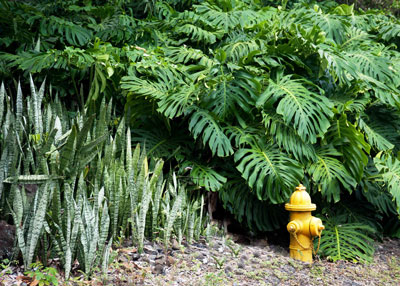Tropical Treasures
Sansevierias, some of which go by the more common names of “snake plant” and “mother-in-law’s tongue,” are durable, water-efficient houseplants for almost any corner — bright or reasonably dark. All you have to do is compensate for the amount of light they receive by watering them less often in darker surroundings.

Part of my collection of sansevierias sitting on our drive waiting to be set into our shaded landscape.
Outdoors? Yes! (In the summer.)
But this little piece is to encourage you to use them outdoors, in shade beds that otherwise seem a little bit drab to your eye. I collected sansevierias for several years, and at my high-water mark, I had upwards of 75 types. They really are a fascinating group of plants. They spent the winters in my greenhouse (still do), and in the mid-spring, we brought them out into the landscape.

Sansevierias brighten a part of our gardens where it would be very difficult to grow flowering plants.
I’ve narrowed the collection down now to probably my favorite 20 or so types. Some are tall and ultimately vertical, while others are short and somewhat arching in their leaf habits. Some are green or gray-green. Others are variegated white or yellow. Many are extremely fibrous. Their leaves were part of a government study during World War II, when hemp fiber was in short supply and alternatives were being tested. Some sansevierias still carry their government testing numbers 70-plus years later.
Because I’m going to move them back into the greenhouse in cold weather, I don’t plant my sansevierias directly into the ground. (You could in the Rio Grande Valley.) I leave them in clay pots, but I sink the pots slightly more than halfway into the soil to keep the top-heavy plants from toppling over.
You have to grow sansevierias in very highly porous potting soil. I choose an extremely lightweight professional mix, then I incorporate 25 to 30 percent (by volume) expanded shale. That way I don’t have to worry about years when we receive 70 inches of rainfall, as we did last year in McKinney.
Not our yard, but fun to see…
Four years ago, as we were visiting the Big Island of Hawaii, I was delighted to see sansevierias being used in their regular landscaping. I thought you might enjoy seeing these two additional photographs.

I also collect photos of fireplugs, so this photograph partially up the road to Holuakoa of a fire hydrant with sansevierias growing alongside was a must.

Finally, right along the Kona Coast, sansevierias alongside bromeliads and colorful Ti plants. I like it! How about you?
